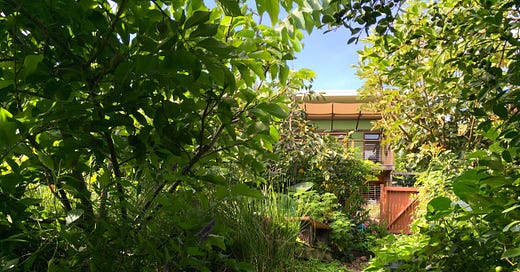Urban food forests: what it really means to grow peaches on Peachtree Street
Urban food forests can have multiple benefits for neighborhoods and cities
On Friday, I wrote about how backyard gardens can mitigate climate change in multiple ways. I’d like to continue the theme today, on Science Monday, with some recent research out of Florida International University that has found multiple benefits from urban food forests.
A food forest is an amalgamation of food bearing plants—fruit trees, food bearing shrubs, along with regular garden staples, such as tomatoes corn, or kohlrabi—that mimics the setting of a natural forest, with an overstory of trees, an understory of shrubs, and a further story of low-growing or ground-level plants. Food forests may be the oldest type of farming done by human beings.
They have been touted as being more beneficial to the soil than many traditional farming practices as well as industrial agriculture. Farm forests attract native pollinators, while naturally reducing the number of pests. Evidence is beginning to show that food forests that are adjacent to open spaces or nature preserves are ecologically beneficial. Food forests in Sri Lanka have been shown to benefit native birds.
The researchers looked at ten food forest gardens that had been installed at ten schools in Miami-Dade County. The food forests were sponsored by a local program, Food Forests For Schools, which is part of a county-wide education organization, The Education Fund. The forests had been installed over the past year to six years and were from a quarter to a full acre in size. The research team was led by Cara A. Rockwell, a research assistant professor at the Institute of Environment at Florida International University. The results of this research were published in the journal Urban Planning in June.
With overstories and understories, the food forests had a lot more species richness compared to nearby urban forests. When scientists talk about species richness of plants, they mean that there are a whole bunch of different plants. Having a whole bunch of different plants helps to ensure that there are a variety of things blooming and blooming at different times of the year, which is helpful to pollinators. More plant diversity also provides more habitat and food for birds and other creatures. It is also nice for people to have blooms to view and flowers to smell over several months instead of just a few weeks
.
The researchers also found that the food forests provided about as much shade as the urban forests. Shade from trees alleviates what is called the urban heat island effect, the tendency of urban areas, with all their concrete, metal, and blacktop, to be warmer than the surrounding countryside. Depending on the size of the city and if it’s a sunny day or not, urban areas can be as much as seven degrees Fahrenheit hotter than nearby outlying areas. Nighttime temperatures can be five degrees hotter. The authors say that urban food forests can be part of the plan to mitigate global warming, as already over-heated cities get even hotter. Not only do tree canopies and forest farms cool in their direct shade, but their cooling effect has been measured even several blocks away from where they are.
Nutrition was not part of the study, but in summarizing their findings, the scientists state that urban food forests, or even just including fruit trees in already existing urban forests, can enhance the nutrition and well-being of city folk, particularly individuals with lower incomes or where there are food deserts.
Some poorer neighborhoods are not only food deserts, they bake in the summer, unshaded. In a separate study from last year researchers examined 37 metropolitan areas in the United States and found that shade from tree canopies in minority neighborhoods was almost half that of white neighborhoods (23% for minority neighborhoods, compared to 43% for white neighborhoods). Other recent research finds similar discrepancies. Planting urban food forests could have the advantages of being oases in food deserts as well as bringing some much needed shade.
Lastly, the authors of the paper mention that food forests, with their stands of trees and shrubs, sequester carbon, mitigating global heating. Food forests seem like such a benefit across the board, I’m wondering why I haven’t heard more about them. If you live where there are food forests, please let me know. I’m wanting to find examples that folks can tell me about. I want to know what it’s like to actually farm a food forest.
For more environmental science & news follow me on Twitter @EcoScripsit.






Urban gardening on a large scale will need community pressure on gov. and landlords. In San Diego water availability/usage is a concern.
On an encouraging note, our local elementary has over the last 5-10 years developed a small but inviting urban food forest. Not sure the design was intentional or evolutionary, but the vegetable and fruit garden is now a somewhat messy but cooling environment adjacent to the traditional asphalt parking lot.